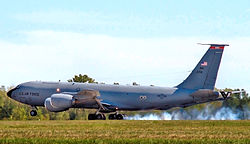Rickenbacker Air National Guard Base
This article includes a list of general references, but it lacks sufficient corresponding inline citations. (December 2014) |
| Rickenbacker Air National Guard Base | |||||||||
|---|---|---|---|---|---|---|---|---|---|
| Near Columbus, Ohio in the United States | |||||||||
 A KC-135R Stratotanker of the Ohio Air National Guard's 121st Air Refuelling Wing touches down at Rickenbacker ANGB during 2012. | |||||||||
 | |||||||||
| Coordinates | 39°48′49″N 082°56′48″W / 39.81361°N 82.94667°W | ||||||||
| Type | Air National Guard Base | ||||||||
| Site information | |||||||||
| Owner | Department of Defense | ||||||||
| Operator | US Air Force (USAF) | ||||||||
| Controlled by | Ohio Air National Guard (ANG) | ||||||||
| Condition | Operational | ||||||||
| Website | www | ||||||||
| Site history | |||||||||
| Built | 1940s (as Lockbourne Army Airfield) | ||||||||
| In use | 1940s – present | ||||||||
| Garrison information | |||||||||
| Current commander | Colonel David B. Johnson | ||||||||
| Garrison | 121st Air Refueling Wing | ||||||||
| Airfield information | |||||||||
| Identifiers | IATA: LCK, ICAO: KLCK, FAA LID: LCK, WMO: 724285 | ||||||||
| Elevation | 226.7 metres (744 ft) AMSL | ||||||||
| |||||||||
| Airfield shared with Rickenbacker International Airport. Source: Federal Aviation Administration[1] | |||||||||
Rickenbacker Air National Guard Base is an Ohio Air National Guard installation at Rickenbacker International Airport near Lockbourne in southern Franklin County. The base was named for the famous early aviator and Columbus native Eddie Rickenbacker. It is the home of the 121st Air Refueling Wing (121 ARW), an Air National Guard (ANG) unit that serves as the host wing and operates in federal service under the United States Air Force Air Mobility Command (AMC). OH-121, a Civil Air Patrol squadron, also operates on the base.
Rickenbacker ANGB operates at the airport as a tenant of the Columbus Regional Airport Authority, sharing the facility with commercial airlines and other civilian aircraft operators. The air base is a joint military facility whose own tenant activities include the Ohio Army National Guard's Army Aviation Support Facility #2, Navy Reserve and Marine Corps Reserve units, and associated facilities.
During World War II, the installation was a U.S. Army Air Forces training base known as Lockbourne Army Airfield, becoming an Air Force base in 1948 a few months following the establishment of the United States Air Force as an independent branch of the U.S. armed forces. The base was named Lockbourne AFB from 1948 to 1974 and later Rickenbacker AFB from 1974 to 1980. The facility was transferred from Strategic Air Command and the active duty Air Force on 1 April 1980 and turned over to the Air National Guard.
Further reading
![]() This article incorporates public domain material from the Air Force Historical Research Agency
This article incorporates public domain material from the Air Force Historical Research Agency
![]() This article incorporates public domain material from Rickenbacker Air National Guard Base. United States Air Force.
This article incorporates public domain material from Rickenbacker Air National Guard Base. United States Air Force.
- ^ "Airport Diagram – Rickenbacker Intl (LCK)" (PDF). Federal Aviation Administration. 16 July 2020. Retrieved 22 July 2020.
- Maurer, Maurer. Air Force Combat Units of World War II. Washington, DC: U.S. Government Printing Office 1961 (republished 1983, Office of Air Force History, ISBN 0-912799-02-1).
- Ravenstein, Charles A. Air Force Combat Wings Lineage and Honors Histories 1947–1977. Maxwell Air Force Base, Alabama: Office of Air Force History 1984. ISBN 0-912799-12-9.
- Mueller, Robert, Air Force Bases Volume I, Active Air Force Bases Within the United States of America on 17 September 1982, Office of Air Force History, 1989
- Futrell, Robert Frank (1983) The United States Air Force in Korea, 1950–1953, Maxwell AFB, Alabama Office of Air Force History, ISBN 0-912799-71-4
- Lloyd, Alwyn T. (2000), A Cold War Legacy, A Tribute to Strategic Air Command, 1946–1992, Pictorial Histories Publications ISBN 1-57510-052-5
- Rogers, Brian (2005). United States Air Force Unit Designations Since 1978. Hinkley, England: Midland Publications. ISBN 1-85780-197-0.
- Turner Publishing Company (1997), Strategic Air Command: The Story of the Strategic Air Command and Its People. Turner Publishing Company ISBN 1-56311-265-5
- Manning, Thomas A. (2005), History of Air Education and Training Command, 1942–2002. Office of History and Research, Headquarters, AETC, Randolph AFB, Texas OCLC 71006954, 29991467
- Shaw, Frederick J. (2004), Locating Air Force Base Sites, History’s Legacy, Air Force History and Museums Program, United States Air Force, Washington DC. OCLC 57007862, 1050653629
- USAAS-USAAC-USAAF-USAF Aircraft Serial Numbers – 1908 to present
- ArmyAirForces.com
- Strategic-Air-Command.com
- American Military Aircraft (RB-29, RB-45, EB-47, RB-47)
- Air Force Historical Research Agency
- Rickenbacker International Airport Official Website
(Source of much of early history and information about turnover to civil authorities)




